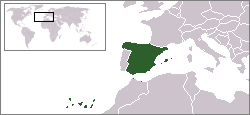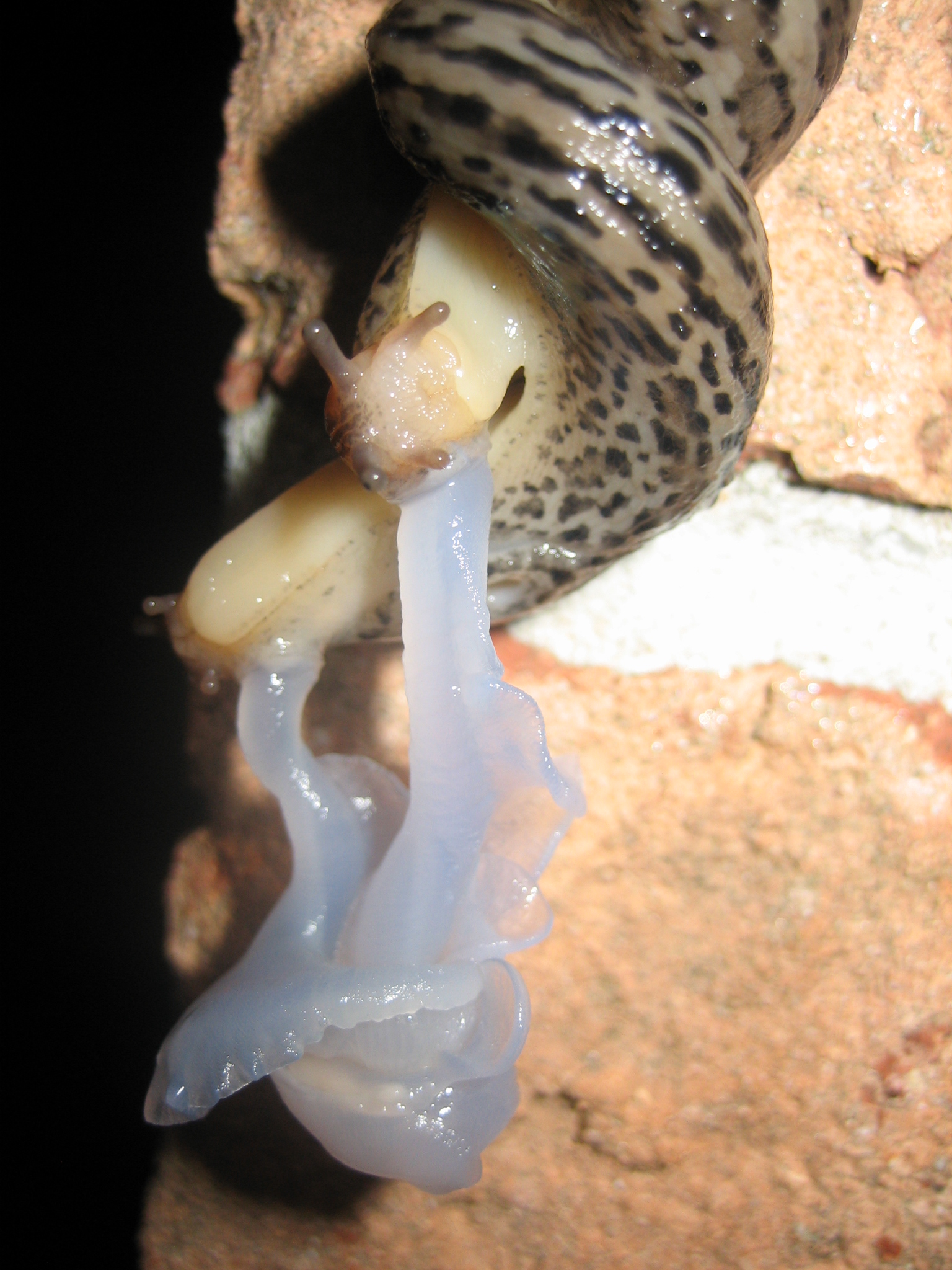|
Geomalacus Anguiformis
''Geomalacus anguiformis'' is a species of air-breathing land slug, a terrestrial animal, terrestrial pulmonate gastropod mollusc in the family Arionidae, the round back slugs. Distribution This species occurs in south List of non-marine molluscs of Portugal, Portugal (Serra de Monchique) and central List of non-marine molluscs of Spain, Spain. Description The slug is dark grey with brown hue. It has lighter sides and two light colour bands with dark lower margins running along both sides of the mantle (mollusc), mantle. Mantle is elliptical, extending to tentacles in anterior part. Tentacles are nearly black, thick and not very long. When crawling, the slug has not always a regularly cylindrical shape, there are depressions and dilatations. Sole is light creamy with darker medial zone, with yellowish or greenish hue. Mucus is yellow. ''Geomalacus anguiformis'' is 60 mm long (preserved 30 mm). gastropod shell, Shell is elliptical, solid, upper side convex and lower ... [...More Info...] [...Related Items...] OR: [Wikipedia] [Google] [Baidu] |
Pierre Marie Arthur Morelet
Pierre Marie Arthur Morelet (26 August 1809 – 9 October 1892) was a French natural history, naturalist, born in Lays, Doubs. He was a member of the Commission to Algeria, primarily as a natural artist, drawing any natural findings. He collected specimens in the Canary Islands, Guatemala and Mexico. He had a particular interest in molluscs and was recognised as a leading expert in the field. Morelet married Noémie de Folin, sister of Léopold de Folin. Morelet died of natural causes in 1892, in Dijon. Taxa described Morelet described various taxa, including: * ''Cyclophorus horridulum'' (Morelet, 1882) - a species of land snail * ''Morelet's crocodile, Crocodylus moreletii'' (Morelet, 1850) - a crocodile Taxa named in his honour Taxa named in honour of Arthur Morelet include: * ''Agalychnis moreletii'' (André Marie Constant Duméril, A.M.C. Duméril, 1853) – Morelet's Treefrog * ''Crocodylus moreletii'' (Auguste Duméril, A.H.A. Duméril & Gabriel Bibron, Bibron, 1851) ... [...More Info...] [...Related Items...] OR: [Wikipedia] [Google] [Baidu] |
List Of Non-marine Molluscs Of Spain
The non-marine molluscs of Spain are a part of the molluscan fauna of Spain. Non-marine molluscs of the Canary Islands are listed separately. There are more than 300 species of non-marine molluscs living in the wild in Spain. Freshwater gastropods Neritidae * ''Theodoxus fluviatilis'' (Linnaeus, 1758) Ampullariidae * ''Pomacea insularum'' (d'Orbigni, 1835) - Invasive species Viviparidae * ''Cipangopaludina chinensis'' (J. E. Gray, 1833) - Invasive species * ''Sinotaia quadrata'' (Benson, 1842) - Invasive species Melanopsidae * '' Melanopsis tricarinata dufouri'' * '' Melanopsis penchinati'' Bourguignat, 1868 * ''Melanopsis praemorsa'' (Linnaeus, 1758) Thiaridae * ''Melanoides tuberculata'' (O. F. Müller, 1774) - Invasive species Amnicolidae * '' Bythinella andorrensis andorrensis'' (Paladilhe, 1874) * '' Bythinella batalleri'' Bofill, 1925 - endemic to Spain **''Bythinella batalleri batalleri'' Bofill, 1925 - endemic to Spain **''Bythinella batalleri cuenca'' Boete ... [...More Info...] [...Related Items...] OR: [Wikipedia] [Google] [Baidu] |
AnimalBase
AnimalBase is a project brought to life in 2004 and is maintained by the University of Göttingen, Germany. The goal of the AnimalBase project is to digitize early zoological literature, provide copyright-free open access to zoological works, and provide manually verified lists of names of zoological genera and species as a free resource for the public. AnimalBase contributed to opening up the classical taxonomic literature, which is considered as useful because access to early literature (especially for the late 18th century) can be difficult for researchers who need the old sources for their taxonomic research. AnimalBase data are public domain. The public use of AnimalBase data is not restricted or conditioned.AnimalBase Project Group, 2005-2010. AnimalBase. Early zoological literature online. World wide web electronic publication http://www.animalbase.uni-goettingen.de accessed 30 July 2010. AnimalBase covers all zoological disciplines. In the field of biodiversity informatics A ... [...More Info...] [...Related Items...] OR: [Wikipedia] [Google] [Baidu] |
Geomalacus Oliveirae
''Geomalacus oliveirae'' is a species of air-breathing land slug, a terrestrial pulmonate gastropod mollusc in the family Arionidae, the round back slugs. Distribution Distribution of ''Geomalacus oliveirae'' include: * Portugal (Beira Alta) * Spain (Toledo, Cáceres, Salamanca) - Red List Spain: Sensitive to habitat change (Gómez Moliner et al. 2001). Description ''Geomalacus oliveirae'' is a slug light with 4 black colour bands, inner bands are irregularly interrupted, main marginal bands sharply delimited against the light background. The length of the body of preserved specimen is 20 mm. Reproductive system The reproductive system of an organism, also known as the genital system, is the biological system made up of all the anatomical organs involved in sexual reproduction. Many non-living substances such as fluids, hormones, and pheromones are als ...: Genital retractor inserts more anteriorly in the median line of dorsum than in the other species. Ecology ... [...More Info...] [...Related Items...] OR: [Wikipedia] [Google] [Baidu] |
Irish Naturalists' Journal
The ''Irish Naturalists' Journal'' () is a scientific journal covering all aspects of natural history. It has been published since 1925. It was predecessed by ''The Irish Naturalist'' (1892−1924). References External links *''The Irish Naturalist'' (1892−1924)in Biodiversity Heritage Library The Biodiversity Heritage Library (BHL) is the world’s largest open access digital library for biodiversity literature and archives. BHL operates as worldwide consortiumof natural history, botanical, research, and national libraries working toge ... Biology journals Publications established in 1925 {{biology-journal-stub ... [...More Info...] [...Related Items...] OR: [Wikipedia] [Google] [Baidu] |
Kerry Slug
The Kerry slug or Kerry spotted slug (''Geomalacus maculosus'') is a species of terrestrial, pulmonate, gastropod mollusc. It is a medium-to-large sized, air-breathing land slug in the family of roundback slugs, Arionidae. Adult Kerry slugs generally measure in length; they are dark-grey or brown with yellowish spots. The internal anatomy of the slug has some unusual features and some characteristic differences from the genus ''Arion'', also part of Arionidae. The Kerry slug was described in 1843—later than many other relatively large land gastropods present in Ireland and Great Britain—an indication of its restricted distribution and secretive habits. Although the distribution of this slug species includes south-western Ireland—including County Kerry—the species is more widespread in north-western Spain and central-to-northern Portugal. Given that the slug has thus far been recorded exclusively at locations in Ireland and north-western Iberia, it can be said to ... [...More Info...] [...Related Items...] OR: [Wikipedia] [Google] [Baidu] |
Reproductive System Of Gastropods
The reproductive system of gastropods (slugs and snails) varies greatly from one group to another within this very large and diverse taxonomic class of animals. Their reproductive strategies also vary greatly, see Mating of gastropods. In many marine gastropods there are separate sexes (male and female); most terrestrial gastropods however are hermaphrodites. Courtship is a part of the behaviour of mating gastropods. In some families of pulmonate land snails, one unusual feature of the reproductive system and reproductive behavior is the creation and utilization of love darts, the throwing of which has been identified as a form of sexual selection. Gastropods are defined as snails and slugs, belonging to a larger group called Molluscs. Gastropods have unique reproductive systems, varying significantly from one taxonomic group to another. They can be separated into three categories: marine, freshwater, and land. Reproducing in marine or freshwater environments makes getting s ... [...More Info...] [...Related Items...] OR: [Wikipedia] [Google] [Baidu] |
Gastropod Shell
The gastropod shell is part of the body of a Gastropoda, gastropod or snail, a kind of mollusc. The shell is an exoskeleton, which protects from predators, mechanical damage, and dehydration, but also serves for muscle attachment and calcium storage. Some gastropods appear shell-less (slugs) but may have a remnant within the mantle, or in some cases the shell is reduced such that the body cannot be retracted within it (semi-slug). Some snails also possess an operculum that seals the opening of the shell, known as the Aperture (mollusc), aperture, which provides further protection. The study of mollusc shells is known as conchology. The biological study of gastropods, and other molluscs in general, is malacology. Shell morphology terms vary by species group. Shell layers The gastropod shell has three major layers secreted by the Mantle (mollusc), mantle. The calcareous central layer, tracum, is typically made of calcium carbonate precipitated into an organic matrix known as c ... [...More Info...] [...Related Items...] OR: [Wikipedia] [Google] [Baidu] |
Mantle (mollusc)
The mantle (also known by the Latin word pallium meaning mantle, robe or cloak, adjective pallial) is a significant part of the anatomy of molluscs: it is the dorsal body wall which covers the visceral mass and usually protrudes in the form of flaps well beyond the visceral mass itself. In many species of molluscs the epidermis of the mantle secretes calcium carbonate and conchiolin, and creates a shell. In sea slugs there is a progressive loss of the shell and the mantle becomes the dorsal surface of the animal. The words mantle and pallium both originally meant cloak or cape, see mantle (vesture). This anatomical structure in molluscs often resembles a cloak because in many groups the edges of the mantle, usually referred to as the ''mantle margin'', extend far beyond the main part of the body, forming flaps, double-layered structures which have been adapted for many different uses, including for example, the siphon. Mantle cavity The ''mantle cavity'' is a central fea ... [...More Info...] [...Related Items...] OR: [Wikipedia] [Google] [Baidu] |
Serra De Monchique
The Serra de Monchique (Monchique Range) is a chain of mountains in the western part of the Algarve region of Portugal, about 20 km inshore. The chain's highest point is the peak of Fóia, at 902 m. 774 m high Picota is another notable peak. Description The Monchique Range is the southwesternmost mountain range of the Iberian Peninsula. It is covered in forest and parts of the range have been transformed into eucalyptus, pine and acacia plantations which are detrimental to the native forest cover. The range is named after the town of Monchique, located in the area. Caldas de Monchique is a well-known spa town with geothermal springs also located in this range. Rivers Seixe, Aljezur and Odiáxere have their sources in this range. Geology The Monchique Range is part of the Late-Cretaceous Iberian Alkaline Igneous Province and is related to the Mount Ormonde seamount in the Gorringe Bank. The inselberg is formed primarily of nepheline-syenites ( foyaite, for which 'Foia' ... [...More Info...] [...Related Items...] OR: [Wikipedia] [Google] [Baidu] |
Limax
''Limax'' is a genus of air-breathing land slugs in the terrestrial pulmonate gastropod mollusk family Limacidae. The generic name ''Limax'' literally means "slug". Some species, such as the leopard slug (''L. maximus'') and the tawny garden slug (''Limacus flavus''), are considered garden pests.Ebeling. WChapter 12: Miscellaneous Pests. ''Urban Entomology''. Department of Entomology. UC Riverside. 2002. The genus ''Limax'' ''sensu stricto'' is probably monophyletic.Klee, B. 200Towards a phylogeny of ''Limax'' (Gastropoda: Stylommatophora)''. ''The Malacologist''. Molluscan Forum 2006. Distribution This genus is native to Europe, but at least one species (''L. maximus'') has been introduced into North America. Species The genus ''Limax'' includes at least 33 species: [...More Info...] [...Related Items...] OR: [Wikipedia] [Google] [Baidu] |
List Of Non-marine Molluscs Of Portugal
The non-marine molluscs of Portugal are a part of the molluscan fauna of Portugal. There are numerous species of non-marine molluscs living in the wild in Portugal. Freshwater gastropods Neritidae * '' Theodoxus baeticus'' (Lamarck, 1822) Bithyniidae * ''Bithynia tentaculata'' (Linnaeus, 1758) Hydrobiidae * ''Alzoniella rolani'' (Boeters, 1986) * '' Belgrandia alcoaensis'' C. Boettger, 1963 - endemic to PortugalG.A. Holyoak, D.T. Holyoak & R. Mendes (2017). "Descriptions of two new species of ''Belgrandia'' (Gastropoda:Hydrobiidae) from Central Portugal". Iberus 35(1): 71-83. * '' Belgrandia alvaroi'' G. Holyoak, D. Holyoak & Mendes, 2017 - endemic to Portugal * '' Belgrandia heussi'' C. Boettger, 1963 - endemic to Portugal * '' Belgrandia jordaoi'' G. Holyoak, D. Holyoak & Mendes, 2017 - endemic to Portugal * '' Belgrandia lusitanica'' (Paladilhe, 1867) - endemic to Portugal * '' Belgrandia silviae'' Rolán & Oliveira, 2009 - endemic to Portugal * ''Hydrobia glyca'' ( ... [...More Info...] [...Related Items...] OR: [Wikipedia] [Google] [Baidu] |





